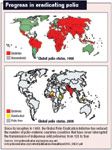Dispatch from India: Final hurdles in the program to eradicate polio
The author traveled to India to learn about the polio eradication effort as a summer project after her first year of medical school. It was a singular opportunity to witness global public health work at its most ambitious.
MS. LANDRIGAN is a third-year medical student at Vanderbilt University School of Medicine, Nashville, Tenn.
The author has nothing to disclose in regard to affiliations with, or financial interests in, any organization that may have an interest in any part of this article.
As the plane bounced lower over the baked flatlands, my only impression of the fast-approaching city was of glaring dustiness, as if someone had turned the brightness level up too high. The city below was Lucknow, the capital of the state of Uttar Pradesh, the largest and most populous state in India-only five nations in the world have more people than Uttar Pradesh. It is also one of the poorest states in India, with some of the lowest levels of education and economic development. My parents had named me India because they loved the country so much, and now as the plane landed, I felt both excited and apprehensive about the weeks that lay ahead in my namesake land.

Promoting awareness-and acceptance
Local planners use a variety of creative ways to accomplish these tasks. National Immunization Days (NIDs) are announced on posters and in radio and television spots by India's most celebrated movie stars and cricket heroes, and traveling bands of musicians and actors put on polio-awareness shows in villages that have no access to television or radio.
Promoting acceptance of the vaccine has become increasingly important in recent years, since rumors in the Muslim world that the vaccine is unsafe have led to strong resistance in some quarters. Because the majority of children with polio in India are from Muslim families, Rotary has focused its efforts on publicizing images of local Islamic religious leaders promoting acceptance of the vaccine, and vaccination days are announced from mosque loudspeakers.
My hope for my six weeks in India was that I would be able to observe and better understand some of the challenges that face the eradication program today. I had planned my trip so that I would arrive the day before an NID was scheduled to begin. These "days" last almost two weeks in Uttar Pradesh, so my plan was to get a feel for the vaccination aspect of the program first and then move on to surveillance.
A vast undertaking
The NID involves a multifaceted approach to vaccinate every child in India younger than 5 years with oral polio vaccine. The oral vaccine has the advantage of being able to immunize close contacts of the vaccinated individual by secondary spread, since the vaccine virus is transmitted via the fecal-oral route, just like the wild poliovirus. During one NID, some 2.5 million volunteers all across India vaccinated more than 165 million children in a matter of days.
The scope of such an endeavor is difficult to grasp, given the fact that, in areas of India like Uttar Pradesh where there is ongoing polio transmission, these vaccination rounds are now occurring as many as eight times per year. These extra local NIDs are called subnational immunization days (SNIDs). The numerous rounds of yearly vaccination during NIDs and SNIDs mean that many children in Uttar Pradesh are vaccinated 20 to 30 times by age 5. This is not considered overkill, since it can take many doses of oral vaccine to achieve immunity: The oral vaccine must compete for receptor sites both with many other viruses in the gut as well as with itself, since it is a trivalent vaccine containing antigens to all three types of polio.